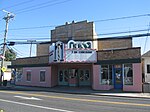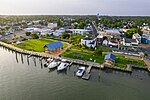John B. Whealton Memorial Causeway

The John B. Whealton Memorial Causeway, more commonly known to the locals as the Chincoteague Causeway, connects the mainland of the Eastern Shore to Chincoteague, where it continues into town as Maddox Boulevard. The causeway is part of State Route 175 (Chincoteague Road). The causeway contains five bridges and crosses the following (west to east): Mosquito Creek via the Mosquito Creek Fixed Bridge Cockle Creek via the Cockle Creek Fixed Bridge Queen Sound via the Queen Sound Fixed Bridge Wire Narrows via the Wire Narrows Fixed Bridge Black Narrows and Lewis Creek Channel via the Chincoteague Channel Drawbridge and Marsh Island ConnectorThe original causeway contained six bridges. The route crossed the Black Narrows and Chincoteague Channel via separate bridges which took the causeway across Marsh Island, landing in town between Mumford and Cleveland Streets. The former a fixed bridge, the latter a swing bridge, they were both removed in late 2010 after the construction of the new bridge. The Marsh Island Connector is a short spur bridge connecting the Marsh Island community to the new bridge. The spur joins the main bridge at a T-intersection over the water, and is a rare example of a three-way bridge.
Excerpt from the Wikipedia article John B. Whealton Memorial Causeway (License: CC BY-SA 3.0, Authors, Images).John B. Whealton Memorial Causeway
Chincoteague Road,
Geographical coordinates (GPS) Address Nearby Places Show on map
Geographical coordinates (GPS)
| Latitude | Longitude |
|---|---|
| N 37.935001 ° | E -75.418491 ° |
Address
Chincoteague Road
Chincoteague Road
23415
Virginia, United States
Open on Google Maps









